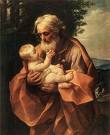March 19

In New Orleans, Carnival season doesn’t end with Mardi Gras, it just gets going. On the heels of the Mardi Gras and St. Patrick’s Day comes St. Joseph’s Day, one of the biggest celebrations of the year.
Saint Joseph is the Patron Saint of Italy; he’s particularly revered in Sicily, where prayers to the saint are believed to have ended a deadly drought in the Middle Ages. His Feast Day is celebrated by Italian communities throughout Europe and the Americas. And March 19 is celebrated as Father’s Day in countries like Italy, Spain, Portugal, Bolivia and Honduras.
+ + +
In New Orleans, Saint Joseph’s Day has long been celebrated by Italian-American communities. Just as the Irish throw cabbage, carrots, and potatoes in the New Orleans St. Patrick’s Day parades, the Italians have recently begun throwing spaghetti (thankfully uncooked and in boxes). Just don’t throw meatballs, as St. Joseph’s Day falls in the middle of Lent.
But the stars of Saint Joseph’s Day aren’t Italian at all. They’re the Mardi Gras Indians. The Mardi Gras Indians consist of dozens of “tribes”, centered around African-American communities. The tribes have names such as the Golden Eagles, Wild Tchoupitoulas, Fi Ya Ya, Creole Wild West, Cheyenne Hunters, Yellow Pocahontas, and Guardians of the Flame. They meet throughout the year, but come Carnival season the tribes really strut their stuff. Literally. The tribes blend West Indian and African roots with Native American traditions to create some of the most incredible outfits, or “suits”, you’ll ever see.
The suits involve hundreds of feathers, beads, and other ornamentations. Tribe members—the Chiefs especially—can spend all year, and thousands of dollars, on a single outfit, and do so year after year.
The traditions and rivalries go back to at least WWI, though in not as formalized a way. Tradition holds that the Chiefs of each tribe confront each other and present their suits on Mardi Gras and Super Sundays (the Sundays closest to St. Joseph’s Day), surrounded by their designated Flag Boys, who carry banners and totems. Each Chief spreads his wings to emphasize the beaded panels hanging from his arms and chest.

Around 1970 the ceremonies were moved from the evening of St. Joseph’s Day to the nearest Sunday afternoon, making it a more family-friendly event, but the Mardi Gras Indians still meet and celebrate on March 19th as well.
Most years, there are actually two Super Sundays, usually one on either side of March 19. One is led by the Uptown Indians, called “New Orleans Mardi Gras Indian Council’s Super Sunday,” and the other by the Downtown Indians, called “Tambourine and Fan.”
The costumes are the most visual, but by no means the only tradition of Super Sundays. The celebrations include singing, dancing, music, and performance.
No one’s sure why the tribes celebrate on St. Joseph’s Day.
According to the late Chief “Tootie” Montana, interviewed by the NY Times in 2004, it’s because “the Italians and us were like this,” he said holding two fingers together.
Montana, the “Godfather of the Chiefs” had been a involved with the Indians for over a half-century when he died of a heart attack at a New Orleans City Council meeting on June 27, 2005. His last act was to testify against police violence towards the Indians during the celebrations.
“With 83 years under his belt, this man came to the podium and reviewed interactions with the police over the past 52 years he’s been involved. Tootie astutely blew holes in all of Mayor Nagin’s exhortations by describing the police violence he has seen and experienced over his many years as Chief…His last words were ‘This has got to stop,’ and he turned from the podium, slumping towards the floor.”

Montana died just two months before Hurricane Katrina. Over the past several years, the Mardi Gras Indians have worked to overcome the double tragedy of the loss of the Chief of Chiefs and the devastation of Hurricane Katrina.
Describing one recent St. Joseph’s Day confrontation between tribal chiefs, the New Yorker writes,
“This was the moment, in the old days, when a knife would flash, a shot would pop, a broken bottle would fly. But the legacy of Tootie Montana and countless other chiefs who have striven to transform Indian culture from gang warfare to street art held firm. The drumming and chanting reached a crescendo, then burst and faded. The two chiefs laughed and embraced; the sweaty crowd applauded, took swigs from bottles of water and beer, and moved on down the avenue to find another battle.”
http://www.bigeasy.com/new-orleans-events/mardi-gras/indians.html
